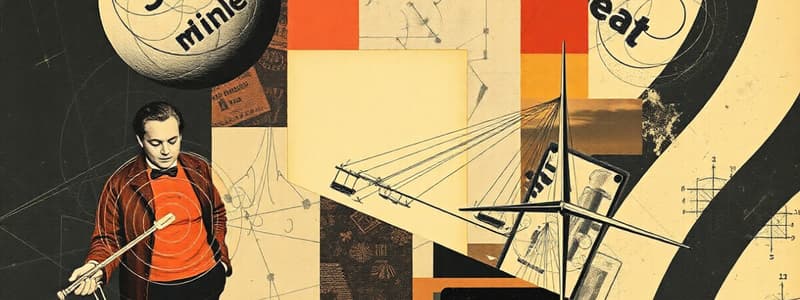Podcast
Questions and Answers
What is the result of the operation A ∪ B if A = {5, 6} and B = {6, 7, 8}?
What is the result of the operation A ∪ B if A = {5, 6} and B = {6, 7, 8}?
- {5, 6, 7, 8} (correct)
- {5, 6}
- {7, 8}
- {6, 7}
How is the symmetric difference A ⊕ B defined?
How is the symmetric difference A ⊕ B defined?
- Elements in either A or B, but not in both (correct)
- All elements in A excluding those in B
- Elements in both A and B
- Elements that are common to both A and B
What does the intersection A ∩ B yield when A = {2, 4, 6} and B = {1, 2, 3}?
What does the intersection A ∩ B yield when A = {2, 4, 6} and B = {1, 2, 3}?
- ∅
- {2} (correct)
- {4, 6}
- {1, 2, 3}
What is the difference A − B when A = {3, 4, 5} and B = {4, 5, 6}?
What is the difference A − B when A = {3, 4, 5} and B = {4, 5, 6}?
Which of the following represents the Cartesian product of A = {1, 2} and B = {x, y}?
Which of the following represents the Cartesian product of A = {1, 2} and B = {x, y}?
If U = {1, 2, 3, 4, 5} and A = {2, 4}, what is the complement of A?
If U = {1, 2, 3, 4, 5} and A = {2, 4}, what is the complement of A?
Given A = {a, b, c} and B = {b, c, d}, what is A ∩ B?
Given A = {a, b, c} and B = {b, c, d}, what is A ∩ B?
What is the result of A ⊕ B if A = {1, 2, 3} and B = {2, 3, 4}?
What is the result of A ⊕ B if A = {1, 2, 3} and B = {2, 3, 4}?
What is the correct definition of a set?
What is the correct definition of a set?
Which of the following statements is true regarding the equality of sets?
Which of the following statements is true regarding the equality of sets?
What is the cardinality of the set A = {a, b, c, d}?
What is the cardinality of the set A = {a, b, c, d}?
Which set represents the power set of A = {a, b}?
Which set represents the power set of A = {a, b}?
Which of the following defines an infinite set?
Which of the following defines an infinite set?
What does the notation |A| represent?
What does the notation |A| represent?
Which statement correctly represents the set of natural numbers?
Which statement correctly represents the set of natural numbers?
What is a subset?
What is a subset?
What is the result of the Cartesian product for sets A = {1, 2}, B = {a, b}, and C = {5, 6}?
What is the result of the Cartesian product for sets A = {1, 2}, B = {a, b}, and C = {5, 6}?
Which of the following properties describes the relationship between the intersection and union of sets?
Which of the following properties describes the relationship between the intersection and union of sets?
When are two ordered n-tuples considered equal?
When are two ordered n-tuples considered equal?
What is the result of A × ∅ if A is a non-empty set?
What is the result of A × ∅ if A is a non-empty set?
Which of the following is NOT a property of the empty set?
Which of the following is NOT a property of the empty set?
According to De Morgan's laws, which statement is true?
According to De Morgan's laws, which statement is true?
What does the theorem regarding the addition principle state for finite sets A and B?
What does the theorem regarding the addition principle state for finite sets A and B?
Which of the following statements about the Cartesian product is true?
Which of the following statements about the Cartesian product is true?
Flashcards
What is a Set?
What is a Set?
An unordered collection of distinct objects. The objects within a set are called "elements" or "members".
What is the set of Natural Numbers (N)?
What is the set of Natural Numbers (N)?
The set of natural numbers, denoted by 'N', is defined as {1, 2, 3, ...}. While some include 0, others exclude it. This set is used for counting.
What is the set of Integers (Z)?
What is the set of Integers (Z)?
The set of all integers, denoted by 'Z', is given by {..., −3, −2, −1, 0, 1, 2, 3, ...}. It includes all whole numbers (positive, negative, and zero).
When are two Sets equal?
When are two Sets equal?
Signup and view all the flashcards
What is a Finite Set?
What is a Finite Set?
Signup and view all the flashcards
What is an Infinite Set?
What is an Infinite Set?
Signup and view all the flashcards
What is the Power Set of a Set?
What is the Power Set of a Set?
Signup and view all the flashcards
What is the set of Rational Numbers (Q)?
What is the set of Rational Numbers (Q)?
Signup and view all the flashcards
Union (A ∪ B)
Union (A ∪ B)
Signup and view all the flashcards
Intersection (A ∩ B)
Intersection (A ∩ B)
Signup and view all the flashcards
Difference (A - B)
Difference (A - B)
Signup and view all the flashcards
Complement (A̅)
Complement (A̅)
Signup and view all the flashcards
Symmetric Difference (A ⊕ B)
Symmetric Difference (A ⊕ B)
Signup and view all the flashcards
Ordered Pair
Ordered Pair
Signup and view all the flashcards
Cartesian Product (A × B)
Cartesian Product (A × B)
Signup and view all the flashcards
n-tuple
n-tuple
Signup and view all the flashcards
Ordered n-Tuple
Ordered n-Tuple
Signup and view all the flashcards
Cartesian Product of n Sets
Cartesian Product of n Sets
Signup and view all the flashcards
Equality of n-tuples
Equality of n-tuples
Signup and view all the flashcards
Union of sets
Union of sets
Signup and view all the flashcards
Intersection of sets
Intersection of sets
Signup and view all the flashcards
Difference of sets
Difference of sets
Signup and view all the flashcards
Complement of a set
Complement of a set
Signup and view all the flashcards
Cardinality of a set
Cardinality of a set
Signup and view all the flashcards
Study Notes
Discrete Structures - Sets
- A set is an unordered collection of distinct objects.
- Elements in a set are called members or elements.
- Order within a set is irrelevant. {a, b, c} = {c, b, a}
- Duplicates in a set do not change the set. {a, b, c, a} = {a, b, c}
- The set of natural numbers (N) is {1, 2, 3,...}
- The set of integers (Z) is {..., -3, -2, -1, 0, 1, 2, 3,...}
Sets and Subsets
- A subset of a set A is a set containing only elements of A.
- The power set of a set A (P(A)) is the set of all subsets of A.
- If A = {a, b}, then P(A) = {∅, {a}, {b}, {a, b}}
Operations on Sets
- Union (A ∪ B): The set containing all elements in A or B, or both.
- A ∪ B = {x | x ∈ A or x ∈ B}
- Intersection (A ∩ B): The set containing only elements common to both A and B.
- A ∩ B = {x | x ∈ A and x ∈ B}
- Difference (A – B): The set containing elements in A but not in B.
- A – B = {x | x ∈ A and x ∉ B}
- Complement (Ac): The set of elements in the universal set (U) but not in set A.
- Ac = U – A
- Symmetric Difference (A⊕B): The set of elements that are in either A or B, but not in both.
- A⊕B = {x | (x ∈ A and x ∉ B) or (x ∈ B and x ∉ A)}
Equality of Sets
- Two sets A and B are equal (A = B) if and only if they have the same elements.
- ∀x[x ∈ A ⇒ x ∈ B and x ∈ B ⇒ x ∈ A]
Cartesian Product
- The Cartesian product of two sets A and B (A × B) is the set of all ordered pairs (a, b) where a is an element of A and b is an element of B.
- Example: A = {1, 2}, B = {a, b}. A × B = {(1, a), (1, b), (2, a), (2, b)}
Properties of Sets
- Commutative Properties: A ∪ B = B ∪ A and A ∩ B = B ∩ A
- Associative Properties: A ∪ (B ∪ C) = (A ∪ B) ∪ C and A ∩ (B ∩ C) = (A ∩ B) ∩ C
- Distributive Properties: A ∩ (B ∪ C) = (A ∩ B) ∪ (A ∩ C) and A ∪ (B ∩ C) = (A ∪ B) ∩ (A ∪ C)
- Properties of Complement: (Ac)c = A, A ∪ Ac = U, A ∩ Ac = ∅
- Properties of a Universal Set: A ∪ U = U, A ∩ U = A
- Properties of the Empty Set: A ∪ ∅ = A, A ∩ ∅ = ∅
Cardinality
- The number of distinct elements in a finite set is its cardinality (|A|)
Addition Principle
- If A and B are finite sets, then |A ∪ B| = |A| + |B|
Studying That Suits You
Use AI to generate personalized quizzes and flashcards to suit your learning preferences.




